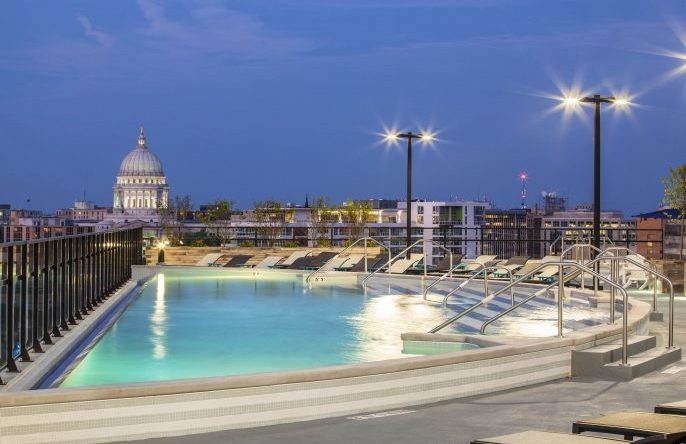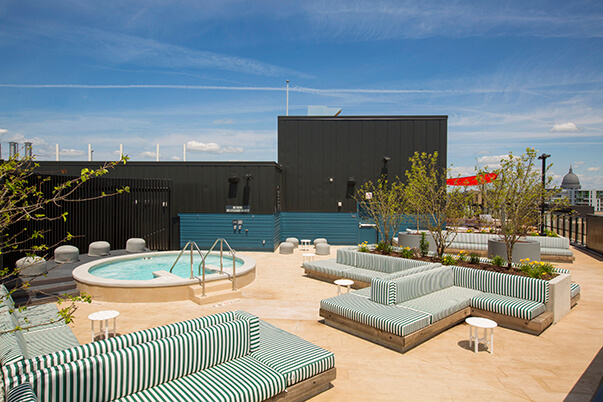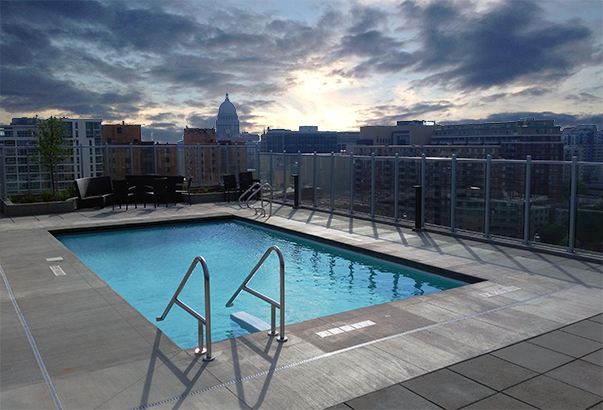Rooftop pools are hot. Here’s how to design them.
ramaker insights
Rooftop pools are hot. Here’s how to design them.
Demand for rooftop pools is heating up, especially in densely populated areas. Our aquatic designers explain why these pools are gaining traction and provide some essential rooftop pool design tips.
As one of the most sought-after amenities in hotels, apartments, and community centers, pools are beneficial to developers and the end-users they hope to attract. But what are developers to do when limited space and high land costs complicate pool installations?
They install rooftop pools.
Having already attracted the attention of annual rankings and social media influencers, rooftop pools are one of the most exciting types of pools for urban residents and travelers alike. Creating a luxurious rooftop pool experience, however, requires a lot of coordination and creativity from aquatic design teams.
In this post, we explain what developers need to know about rooftop pool design. What benefits do rooftop pools provide for end users? What is the design and engineering process like? We take on these questions—and more—over the course of this blog.

Benefits of rooftop pools
Apartment and hotel rooftops are typically neglected. Many are used as hiding places for mechanical storage. Installing a rooftop pool adds immediate value to this under-appreciated space. With limited soundproofing and concealment efforts for mechanical equipment, the site development area can readily be increased—all without taking up valuable at-grade space.
Adding usable space and value to a property are both important. But let’s not forget the main incentive for installing a rooftop pool: guests and residents love them. The appeal of an expertly designed pool that offers breathtaking skyline views can make your property more competitive and attract more tenants.


5 aquatic design considerations for rooftop pools
It takes a lot of planning and a strong project team to design a rooftop pool that attracts guests. Many factors contribute to the design. Here are five things to consider before developing a rooftop pool.
Planning and coordination of rooftop pools
Successful rooftop pool projects result from meticulous planning and coordination. It all starts with location selection. Offering the best views is a key consideration for developers and architects. Structural planning matters, too. The layout for the deck, accessibility of the rooftop for patrons, and bathroom facilities are all important elements that must be planned out in advance. Pipes, pumps, and water treatment equipment also factor into a rooftop pool’s design. It’s the job of aquatic designers and the rest of the project team to coordinate all these elements into a sound plan.
Rooftop pool code compliance
Pool codes regarding patron access and facility design vary significantly depending on location and building type. These components must be evaluated for code compliance before and during the construction of the rooftop pool. A deep understanding of environmental conditions is necessary to maintain code compliance as well.
A big part of code compliance is the pool’s pipe system. Although this may seem like a straightforward element to address, piping appears under many areas of the pool and roofing. The pipes’ pathway needs to go from the pool to the equipment room while accounting for the roof’s structural, mechanical, and plumbing components. Therefore, proper pipe placement matters for access, ease of pool maintenance, and potential repairs down the road.
For the best results, the architects and aquatic, structural, and mechanical engineers must coordinate to make sure the pool’s piping and equipment room are efficiently designed and up to code.

Determining the best type of rooftop pool for the building
Now, to the pool itself. In a nutshell, there are two types of rooftop pools: those raised on podiums above a roof’s surface, and those placed within waterproof vessels (called “structural vaults”). Each building is unique. The project team has to consider which of the two designs works best for the roof.
Regardless of which approach an aquatic designer takes, the pool should ultimately be designed in a way that distributes water weight equally amongst supporting walls and pillars. This tactic is important to prevent leakage. Choosing the best type of pool for your building also means all parties understand pipe penetrations and waterproofing details before deciding which rooftop pool to develop.
Structural engineering and design for rooftop pools
Structural engineers are vital to the success of any rooftop pool project. These professionals calculate a structure’s supportable weight, decide the location of the pool and pool materials, and account for environmental factors, such as wind speeds and heavy snowfall. Buildings also sometimes move due to ground movement, foundation issues, or depreciation of building materials. These details are important for structural engineers to consider while developing the pool.
Structural engineers also must address the load imposed on the building. Water is heavy. One cubic foot holds around 7.5 gallons (just over 62 pounds). That weight adds up quickly. For the pool to be viable, the building’s structural system from the top of the roof to the building’s foundation must accommodate this hefty addition.

Design aesthetic
Ambiance matters. At the end of the day, the goal of installing a rooftop pool is to transform your roof into the place to be. Creating a space that is comfortable, fun, and safe is an essential element of making a reliable social gathering place for patrons. Tenants need an area in their community to relax and escape from everyday responsibilities. Making that space into a private environment with a great view and plenty of amenities will provide guests and residents a place to enjoy themselves.
Aquatic design services for rooftop pools
Thinking about installing a rooftop pool? Even though these pools share many features with in-ground pools, rooftop pools require keen attention to detail to protect end-users and preserve the building’s structural integrity. It’s important for developers to work with experienced aquatic engineers and designers.
Ramaker’s aquatic design and engineering team partners with commercial and residential real estate developers to design and engineer custom rooftop pools that add appeal for guests and residents.
Planning a project? We’d love to talk to you about it.


![[Background] A river runs through a village at sunset. [Text] What is a Phase 1 Environmental Site Assessment?](https://images.ramaker.com/wp-content/uploads/2022/05/05093435/esa-cover-150x150.png)
![Four gray chairs arranged in a circle in front of a fireplace. [TEXT] 5 ways to maximize ROI on your hotel PIP.](https://images.ramaker.com/wp-content/uploads/2022/05/31120907/pip-roi-cover-150x150.png)